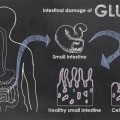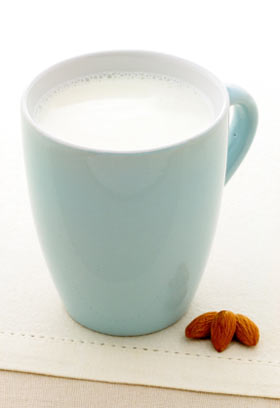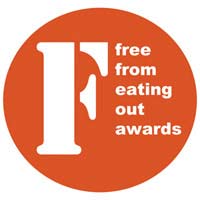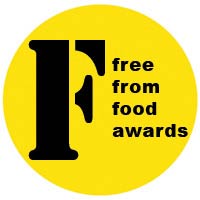Did you know that people with coeliac disease have an increased need for calcium even when they are on a gluten free diet?
 I didn’t. I thought that simply cutting out the gluten and eating a generally healthy diet would be enough. But according to a dietician I met last week at the local Coeliac Society meeting, coeliacs (and people with dermatitis herpetiformis) have an increased risk of osteoporosis even if keeping strictly to a gluten free diet, and that they therefore need more calcium.
I didn’t. I thought that simply cutting out the gluten and eating a generally healthy diet would be enough. But according to a dietician I met last week at the local Coeliac Society meeting, coeliacs (and people with dermatitis herpetiformis) have an increased risk of osteoporosis even if keeping strictly to a gluten free diet, and that they therefore need more calcium.
As the mother of a pre-teen coeliac daughter, this is a bit of a worry. Luckily I’ve always given the children lots of dairy products. But what if you’re not keen on dairy products, or are lactose intolerant?
Recommended daily dose of calcium
The standard recommended dose for adults here in the UK is 700mg per day (Food Standards Agency).
However, the UK Coeliac Society is recommending that coeliac adults should take 1500mg per day, and they provide a guide to daily calcium requirements. The guidelines are different in different countries, so you decide what is appropriate for you (ask a dietician if you are in any doubt – I am not qualified to make recommendations).
| Age | Daily amount mg (CUK) |
Daily amount mg (US) |
| 1-3 years | 350 | 400-800 |
| 4-6 years | 450 | 800 |
| 7-10 years | 550 | 800 |
| 11-18 years | 900 | 800-1200 |
| Adults | 700 | 800-1200 |
| Adults with coeliac disease | 1500 | |
| Pregnant women | – | 1200 |
| Breastfeeding women | 1250 | 1250 |
| Post-menopausal women | 1000 | 1500 |
I can’t find specifics for children with coeliac disease, but I imagine it is safe to assume that it is higher than the standard recommendation for children, but lower than the adult recommendation.
There are apparently some further, specific, recommendations in the US which you might find helpful:
| Age | Daily amount mg (US) |
| Men 25-65 | 1000 |
| Men over 65 | 1500 |
| Women 25-50 | 1000 |
| Women over 50 on HRT | 1000 |
| Women over 50 not on HRT | 1500 |
| Women over 65 | 1500 |
| Pregnant and nursing women | 1200-1500 |
Calcium is found in a variety of foods
The richest sources of calcium are dairy products, but also in fish, dried fruit, leafy green vegetables such as spinach, oranges, nuts and tofu.
| Food | Amount of calcium (mg) |
| 1 glass (200ml or 1/3 UK pint) milk (full-fat, semi-skimmed or skimmed) |
250 |
| 40g or 1 1/2oz cheddar cheese | 250 |
| 1 serving carton fruit yoghurt | 150 |
| Sardines (2, or 1/2 a small tin) | 250 |
| Salmon including bones (3.5 oz of 100g) | 100 |
| Portion fortified gluten free breakfast cereal | 150 |
| 2 slices of calcium enriched gluten free bread | 200 |
| 1 calcium enriched gluten free roll | 250 |
| 1 dried fig or 7 dried apricots | 50 |
| Portion boiled spinach (3.5 oz or 100g) | 150 |
| Shelled almonds (3.5 oz or 100g) | 250 |
| 1 medium orange | 50 |
| Portion of tofu (3.5 oz or 100g) | 500 |
| Portion of baked beans (1/4 large can, or 100g) | 50 |
| Fortified mineral water (200ml) | 50 |
Being strict about the gluten free diet will increase your absorption of nutrients such as calcium, but do make sure that you are eating enough in the first place. Simply work out how much you should be taking using the tables in the first section, then work out what you need to eat in an average day, using the list above, to get to your recommended total.
Not enough?
Most people don’t manage to eat enough calcium. You can take a supplement, but it is recommended that you don’t take more than 1500mg by supplement – and don’t take more than 500mg at a time, as you won’t absorb it all in one go. You might get better results if you take at least part of the supplement at night, and with a glass of milk or apple juice, which can improve the uptake of calcium.
What else can I do?
To be sure that your bones are as strong as possible, you can also do the following:
- get some vitamin D. You can get most of this from sunlight, but if you have dark skin or don’t see the sun much, you can get it in your diet from margarine, oily fish and some dairy products. (I sense another post coming on soon …)
- get some exercise. Yes, I know you’ve heard this before, but it will help strengthen your bones. Make sure it is weight-bearing exercise such as walking or dancing. Anything where you are bouncing up and down on your feet – swimming won’t help in this case.
- keep the amount you drink to below the recommended amount
- reduce the amount of coffee you drink
- … and don’t smoke.
I hope that’s helpful – more thoughts on vitamins soon.
(So, if one child drinks two glasses of milk and eats one portion of cheese, and one of ice-cream, and has milk on their cereal, and …
 |
I’ve written a book summarising what we’ve learnt over 20 years of dealing with the gluten free diet, and it might be just what you’re looking for. It packs the lessons we’ve learned into what I hope is a helpful and straightforward guidebook. It’s available on Amazon, as a paperback or for your Kindle… |






What a great informative post! We do need to get more calcium! Thanks for sharing this!!
I love this information too – thank you so much for posting it.
I’m also very curious to see the difference between the recommended calcium intake in the US vs the UK. I wonder why?
I am scheduled to see the doctor to get a referral (such a mess to see doctors sometimes!) to get my first bone scan. I will print this information for my doctor to see.
I know I have some other things going on thanks to Celiac – I would like to stay on top of things.
This is very helpful!
Thanks a million times over, Lucy!
=)
Kate
Hi Carrie and Kate – glad to see you both.
I don’t know why there is a difference between the two countries recommendations … I suppose they were looking at the results of different studies, but you would hope that the scientific community shared this kind of information, wouldn’t you?
Kate – I hope the bone scan goes well (and that the referral is quick). Is this a ‘just check everything is OK’ scan or have you a particular worry? My daughter had annual x-rays to check that her bones were growing correctly, but she seems to have caught up enough with her peer group now.
No worries, Lucy – It’s just a check up. I’ve never done this before. I was diagnosed and then we moved across the country. I just never did it because my doctors were 2,500 miles away. Excuses, excuses… they are now over. I need to have this done to have a decent baseline for when I’m …ahem…. more mature. lol
=)
Kate
What A Great Article, But as a gluten free person, with issues with dairy intolerance, I find that the very reasons we get told we need calcium and dairy products is for things like
– strong hair
– strong nails
but since going gluten free and minimizing dairy my hair and nails are better, and stronger then ever.
I think the best way to get calcium is to get it the same place the cow gets it from… Leafy Greens… now I do not mean go out and chew on grass…
But rather make sure you are eating lots of calcium rich greens.
I also find taking a multivitamin is a great way to stay on top of things.
Once again a great article
Regards
Lucy the Gluten Free Kiwi
Hi Lucy Ross – I wonder how much calcium there is in grass, compared to say, spinach!
I think my main concern would be for bone health, rather than hair and nails, but as you say, cows seem to do OK. I think it probably is more difficult if you don’t do dairy …
Thanks for your comment.
(I’ve just done a Google search. I can’t see how much calcium there is in lawn-type grass, but I did find out that a cup of chopped dandelion leaves has almost 40 percent as much calcium as a cup of milk. I’d always heard they were good for you)
Dear Lucy
It’s my wedding and i’m looking for a gluten free
champagne ,can you help me with that?
Hi alina
Best wishes for your wedding!
Champagne is naturally gluten free, so the only issues would be if it had been cross-contaminated somehow – watch out for those cocktails…
There is some discussion going on here (https://www.free-from.com/blog/drinks-you-can-and-cant-enjoy-if-youre-gluten-free/) about contamination of oaked red wines, but that shouldn’t affect champagne. There is some useful information here: http://gfkitchen.server101.com/GFAlcohol.htm#Wine which names some brands of champagne which have been checked by the writer (not me).
I will be happy to let my daughter drink champagne when she is old enough, but if you have concerns about any brand, you should check with the individual manufacturers.